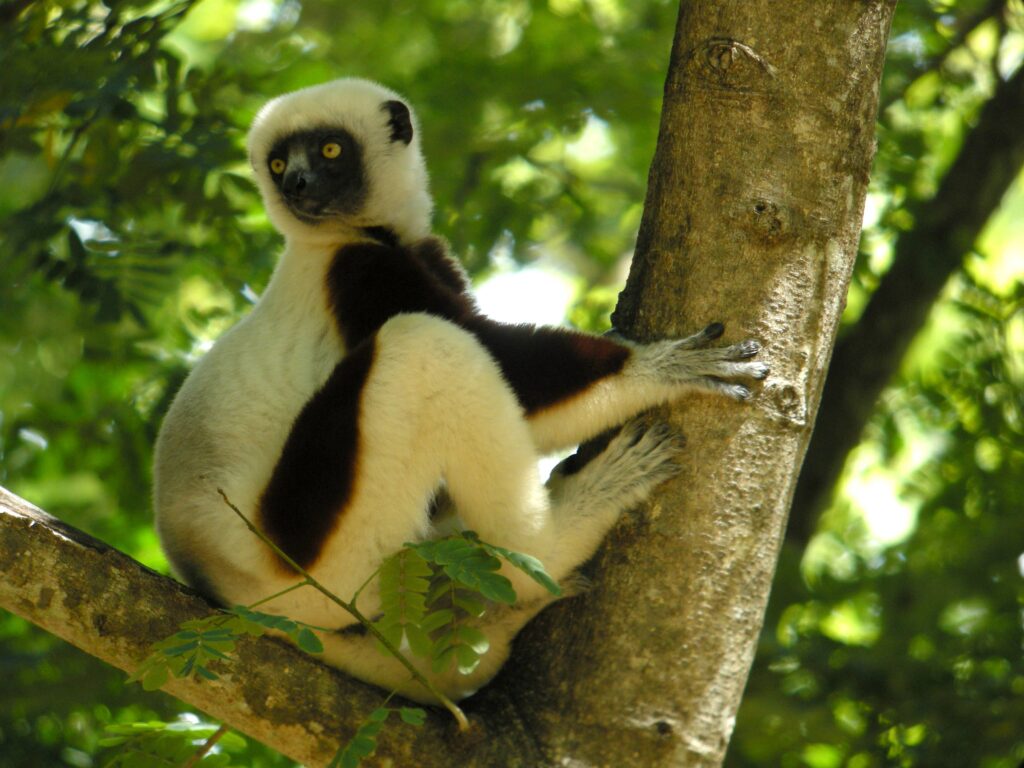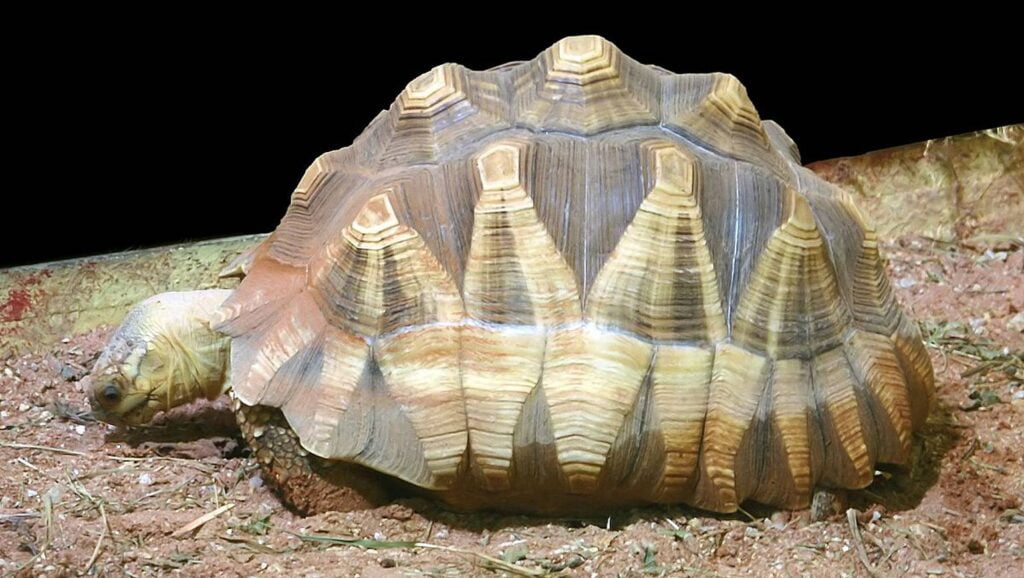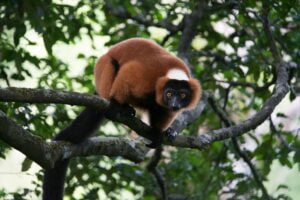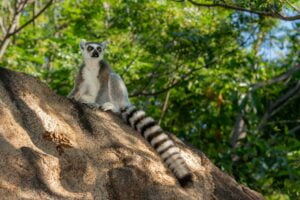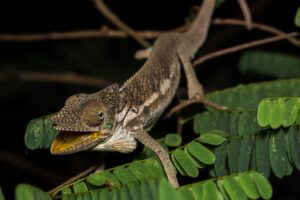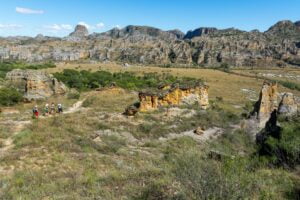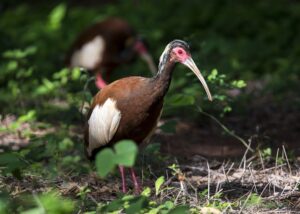
- Madagascar travel
- Mahajanga & Northwest
Mahajanga & Northwest
Guided Tours to Ankarafantsika | Madagascar Travel
Ankarafantsika, located in the northwest of Madagascar, is a vital sanctuary for numerous lemur and bird species, emphasizing the importance of preserving this national park. The name, meaning « thorny mountains, » refers to its renowned canyon. Often called « the kingdom of birds, » the park spans over 130,000 hectares and features diverse ecosystems, including Ravelobe Lake, Ankarokaroka Canyon, and a dense dry semi-deciduous forest. This habitat supports 129 bird species (75 endemic), 8 lemur species, reptiles, and amphibians. With 11 well-maintained trails, visitors can explore the park’s unique ecosystems. Ankarafantsika, especially the Ampijoroa area, is an ideal destination for first-time Madagascar travelers. The accommodations are excellent, and lemur-watching is easily accessible. Lucky visitors might see all eight lemur species, including the elusive mongoose lemur. Knowledgeable guides are crucial for identifying different mouse lemur species. Unique to this site is the chance to spot Microcebus ravelobensis, while the curious Coquerel’s sifakas are easily observable.
The park is a top birdwatching destination, hosting 129 species (75 endemic) such as the banded kestrel, Rufous vanga, Van Dam’s vanga, and the Madagascar fish eagle. Additionally, Ankarafantsika boasts 10 frog and 45 reptile species, including various chameleons, snakes, the rare Madagascar big-headed turtle, and crocodiles around the lake. Ankarafantsika’s flora is impressive, with over 800 species, many endemic, like Cedrelopsis grevei, baobabs, palisander, wild vanilla, retendrika, crocodile tree, lohavato, and the sakoanala tree. The Ampijoroa area is crucial for the world’s most significant captive breeding project for endangered Madagascar turtles and tortoises, including the ploughshare tortoise, flat-tailed tortoise, and Madagascar big-headed sideneck turtle – all critically endangered. The park is the sole breeding site for the ploughshare tportoise outside its natural range.
Visit Mahajanga: Flower City & Wildlife Safaris
Welcome to Mahajanga, the City of Flowers in the legendary Boeny Region, located in the northwest of Madagascar. This vibrant capital is the ideal gateway to numerous undiscovered tourist attractions, offering a rich blend of historical, cultural, and environmental heritage. Globally renowned, Mahajanga captivates visitors with its vibrant skies, beautiful beaches, and colorful landscapes. The port town, adorned with a picturesque waterfront and palm-lined promenade, stands out among Madagascar’s seaside cities. With ethnic diversity, including large Comoran and Indian populations, it is one of the country’s most colorful places. Founded around 1700 by Arabs, Mahajanga (formerly Majunga) retains its Arab and Swahili influence.
This cosmopolitan city is a culinary delight, offering dishes from various regions. It is credited with introducing the samosa, a spiced meat-filled triangular pancake. Praised for its conviviality, nonchalance, and quality of life, Mahajanga comes alive at night on the famous « Bord » seaside promenade. The city’s iconic giant baobab tree, approximately 1000 years old, symbolizes its enduring charm. Photographic opportunities abound, showcasing trading posts, wooden doors reflecting Arabic origins, colonial houses with ochre facades, and narrow streets with bougainvillea gardens. By the seaside, wooden boats transport goods at dawn, adding to the city’s dynamic character.
Sahamalaza National Park: Lemurs, Birds & More
Sahamalaza Îles Radama National Park, a UNESCO Biosphere Reserve turned National Park in 2007, spans 260 km², with half submerged in coral reefs. Located in the northwest of Madagascar, this park is a tourism gem with a variety of guided tours. The terrestrial section features mangroves and rare dry littoral forest, including the Sahamalaza peninsula with steep slopes and two forest blocks. About 40% of species are endemic to Madagascar.
Eight lemur species, including the critically endangered Sahamalaza sportive lemur and the blue-eyed black lemur, are found here. Rediscovered in 1983, the blue-eyed black lemur is among the world’s most endangered primates. The park also hosts other lemur species, reptiles, amphibians, and diverse bird species. The coastal area is rich in marine life, with 200+ coral and invertebrate species, 20 sea cucumbers, and 170 fish species. The coral reefs of Lagna and Ankakabe support sea turtles. With its diverse wildlife and natural beauty, Sahamalaza Îles Radama National Park offers excellent travel and tour opportunities, including mangrove excursions and diving.
Baie de Baly National Park Tours | Madagascar Wildlife Adventures
Explore the hidden gem of Baly Bay, located in the northwest of Madagascar. This lesser-known destination is poised for acclaim, featuring extraordinary beauty and a wealth of wildlife. The 58 km² Baly Bay National Park, established in 1997, is a biodiversity haven with dense dry forests, mangroves, rivers, lakes, white-sand beaches, dunes, and stunning coral reefs. Notably, the endangered ploughshare tortoise with fewer than 2000 individuals remaining, is a highlight.
The park’s rich flora includes vibrant green dense forests and mangroves. It shelters 13 mammal species, including 8 lemurs, 120 bird species, and over 35 reptiles, along with nesting sites for various turtle species. Visitors may spot dolphins and dugongs in the bay’s waters, and divers might encounter the elusive dugong. With over 50 water bird species, including endangered ones, Baly Bay offers a unique blend of natural wonders. Perfect for guided tours, travel, and tourism, it promises an unforgettable experience for those ready to explore Madagascar’s wildlife.
Madagascar Wildlife Tours: Bemanevika - Red Owl, Serpent Eagle, Pochard
Exploring the northwest of Madagascar, particularly the area around Mahajanga, offers an unparalleled experience in Madagascar tourism. Bemanevika, nestled in this volcanic region, is a treasure trove of natural wonder. This unique landscape features forests, savannah grasslands, lakes, bogs, and marshes, creating a remarkable setting for Madagascar wildlife.
The forest in Bemanevika is home to numerous endemic species and valuable medicinal plants, including the red owl and the Madagascar serpent eagle, exclusive to the island. The lakes, some extending over 60 hectares and resembling volcanic craters, are bordered by majestic natural forests.
Among these lakes, Bemanevika is renowned as the sole habitat of the ‘onjy’ (scientifically known as Aythya innotata), a bird once thought extinct but rediscovered here. This has led to Bemanevika’s designation as part of the Protected Areas Complex of Ambohimirahavavy Marivorahona. As a result, Bemanevika is now under strict protection, surrounded by only a few villages. Embarking on a guided tour to this natural haven promises an unforgettable adventure!

